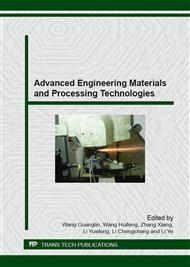p.62
p.68
p.75
p.82
p.88
p.95
p.102
p.108
p.114
Investigation on Cutting Force and Temperature of Cutting Cu50Zr50 Metallic Glass by Molecular Dynamics Simulation
Abstract:
Metallic glasses have a variety of excellent properties compared with the majority of conventional crystalline alloys, and have a broad application prospects in the military, aerospace and sports equipment. Cutting, as an efficient and high-precision machining process, is expected to be an important processing method for metallic glasses. Currently, investigation on cutting metallic glasses is in a nascent stage. Although the machining precision of several tens of nanometers has been achieved, its cutting mechanism remains unclear. In this paper, a molecular dynamics simulation of orthogonal nanometric cutting of metallic glass Cu50Zr50 was carried out.The material deformation, cutting force, and workpiece temperature distribution were studied at microscopic scale. It is found that the deformation accumulation first occurred on the tool rake face. Then with the cutting progressing, materials underwent stable plastic deformation in the shear zone. Analysis on cutting force shows that in the initial material deformation process the cutting force increases rapidly until the cutting process is stabilized, , and then it is reduced to a stable value. Finally, the temperature change of the workpiece during cutting was calculated, and the result shows that the maximum temperature reaches the glass transition temperature. Further, the radial distribution function analysis of workpiece was used to confirm the occurrence of the glass transition.
Info:
Periodical:
Pages:
88-94
Citation:
Online since:
October 2015
Authors:
Keywords:
Price:
Сopyright:
© 2016 Trans Tech Publications Ltd. All Rights Reserved
Share:
Citation:


